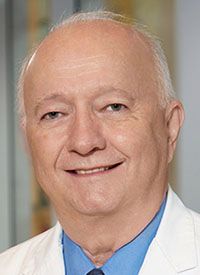Article
Expert Shares Insight on Evolution of Ovarian Cancer Therapeutics
Author(s):
Larry J. Copeland, MD, discusses how therapy for patients with ovarian cancer has evolved in recent years.
Larry J. Copeland, MD, a professor and gynecologic oncologist at The Ohio State University Comprehensive Cancer Center

Larry J. Copeland, MD
Years of research in ovarian cancer have steered to a deeper understanding of the etiology of the disease, and has also led to novel therapeutics to better suit the varied patient populations, explained Larry J. Copeland, MD.
“Our understanding of the etiology of ovarian cancer and how it develops has evolved over the past decade or so, including genetics and the histopathology,” said Copeland. “More than 5 years ago, it seems like we had a practice-changing study that was done every 10 years. Now we are getting practice-changing studies done every 10 months, or even more frequently. It's a pretty exciting time right now.”
In an interview during the 2019 OncLive® State of the Science Summit™ on Ovarian Cancer, Copeland, a professor and gynecologic oncologist at The Ohio State University Comprehensive Cancer Center—James, discussed how therapy for patients with ovarian cancer has evolved in recent years.
OncLive: How would you describe the understanding of ovarian cancer etiology?
Copeland: Regarding the etiology, we feel that a lot of the high-grade serous tumors, which are our biggest enemy, developed from the fimbriae end of the fallopian tube, has translated into a lot of issues. [This theory] helps explain how these patients present. Additionally, there is a high percentage [of patients who] present at an advanced stage, and that's because of the cells exfoliating off the end of the [fallopian] tube.
It also gives us some management opportunities. For example, for women who are having tubal ligation, there's a trend to remove the tube as a preventive strategy. In patients who have a BRCA mutation and are hoping for risk-reducing surgery, historically we would offer removal of both the tubes and ovaries. I had a patient come in about 1 month ago who said, "Dr Copeland, I'm BRCA positive. I just want my tubes removed."
I was excited to have a patient with that potential insight. Unfortunately, we don't have the clinical trial data to absolutely give affirmative information on the value of [removing the fallopian tubes] compared with removing the ovaries. The concept is important because removing ovaries from a 30- or 40-year-old woman is going to decrease her lifespan. Therefore, removing the tubes is a very attractive option.
What have you noticed regarding the prevalence of ovarian cancer, particularly in the United States?
Prevalence is essentially how many patients currently have ovarian cancer. The prevalence trends are up, not because of the frequency of occurrence, but because we're now keeping patients alive for longer intervals and turning it into a chronic disease, which makes the prevalence significantly higher. With all these new clinical trials being done and the molecular markers, that's going to be even further exaggerated.
What are your thoughts on the current ovarian cancer detection strategies and how can they become more widespread in practice?
Making the diagnosis in a timely fashion with the idea of preventing it remains a challenge. With prevention, now we are focused on removing the tubes in a timely fashion. I'm not sure we have made great strides in blood work, urine research, or imaging that gives us the ability to make an early diagnosis.
How has the role of chemotherapy changed with the addition of PARP and angiogenic inhibitors?
The complexity of chemotherapy is confusing, even to experts in the field, and you'll see experts disagree. The core upfront treatment is platinum-based chemotherapy [and people debate] whether intraperitoneal delivery is superior [to other approaches]. Whether to give dose-dense chemotherapy on a weekly schedule as opposed to every 3 weeks is also debated.
We have VEGF inhibitors, including bevacizumab. Should we use that agent upfront or save it for secondary treatment? If we use it upfront, are there select patients who receive the VEGF inhibitor? This is all a jigsaw puzzle that we're still working on trying to put together.
Now, we have the parts that are being thrown in the frontline setting, as well. Additionally, there are immuno-oncology agents coming in. I consider it exciting and confusing. It's going to take some more clinical trials to try and sort out the relative value and the order in which we use all of our current treatments.
What are your thoughts on the progress seen with PARP inhibitors?
As is the case with many new drugs, they're first tested in the recurrent setting and then, when they demonstrate efficacy there, they move up into the frontline setting. That's exactly what is going on with the PARP inhibitors, which is exciting.
However, PARP inhibitors aren't without some downsides. There is a small percent [of patients who] develop a pre-leukemia—type syndrome. I'm old enough to remember a very effective drug we used back in the 1970s and 1980s called melphalan, which ended up not being used because of the leukemia induction. Time will tell. We used melphalan for a number of years thinking it was good, effective, safe, and easy to give. Then, all of a sudden, once it showed its true colors, we couldn't use it. Let's be patient and see how [PARP inhibitors] evolve.
Latest Conference Coverage
%20(2)%201-Recovered-Recovered-Recovered-Recovered-Recovered.jpg?fit=crop&auto=format)
Dr Caimi on Early Data for LMY-920 in R/R B-Cell NHL

Navigating a “Sea Change” in Frontline Urothelial Carcinoma Treatment
%20(2)%201-Recovered-Recovered-Recovered-Recovered-Recovered.jpg?fit=crop&auto=format)
Dr Scalici on Data for IMNN-001 Plus SOC Chemotherapy in Advanced Ovarian Cancer
%20(2)%201-Recovered-Recovered-Recovered-Recovered-Recovered.jpg?fit=crop&auto=format)
Dr Lin on the Safety of NKTR-255 in Enhancing Immune Recovery Post-Chemoradiation in Locally Advanced NSCLC
2 Commerce Drive
Cranbury, NJ 08512





